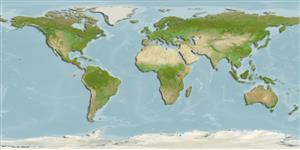Teleostei (teleosts) >
Gobiiformes (Gobies) >
Gobiidae (Gobies) > Gobiinae
Etymology: Bathygobius: Greek, bathys = deep + Latin, gobius = gudgeon (Ref. 45335).
Eponymy: Édouard François André (1840–1911) was a French horticulturalist, landscape architect and designer, famously designing city parks in Monte Carlo and Montevideo before which he was part of the redesign of Paris open spaces. [...] (Ref. 128868), visit book page.
More on author: Sauvage.
Environment: milieu / climate zone / depth range / distribution range
Ecology
Marine; brackish; reef-associated. Tropical
Eastern Pacific: Costa Rica to the northern Peru.
Size / Weight / Age
Maturity: Lm ? range ? - ? cm
Max length : 15.3 cm TL male/unsexed; (Ref. 87607)
Occurs in both tidepools and sublittoral areas (Ref. 87607).
Life cycle and mating behavior
Maturity | Reproduction | Spawning | Eggs | Fecundity | Larvae
Thomson, D.A., 1987. Reef fishes of the Sea of Cortez. The rocky-shore fishes of the Gulf of California. The University of Arizona Press, Tucson. 302 p. (Ref. 5592)
IUCN Red List Status (Ref. 130435: Version 2024-1)
Threat to humans
Harmless
Human uses
Tools
Special reports
Download XML
Internet sources
Estimates based on models
Preferred temperature (Ref.
123201): 22.9 - 29.1, mean 26.9 °C (based on 224 cells).
Phylogenetic diversity index (Ref.
82804): PD
50 = 0.5000 [Uniqueness, from 0.5 = low to 2.0 = high].
Bayesian length-weight: a=0.00724 (0.00339 - 0.01546), b=3.10 (2.92 - 3.28), in cm total length, based on LWR estimates for this (Sub)family-body shape (Ref.
93245).
Trophic level (Ref.
69278): 3.6 ±0.6 se; based on size and trophs of closest relatives
Resilience (Ref.
120179): High, minimum population doubling time less than 15 months (Preliminary K or Fecundity.).
Fishing Vulnerability (Ref.
59153): Low vulnerability (10 of 100).
Nutrients (Ref.
124155): Calcium = 103 [51, 193] mg/100g; Iron = 0.649 [0.329, 1.224] mg/100g; Protein = 18.4 [16.4, 20.1] %; Omega3 = 0.0869 [, ] g/100g; Selenium = 19.4 [8.9, 44.9] μg/100g; VitaminA = 114 [31, 374] μg/100g; Zinc = 1.99 [1.30, 2.93] mg/100g (wet weight);
